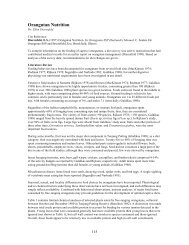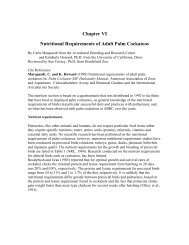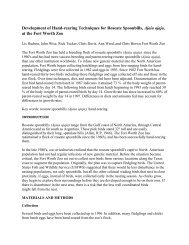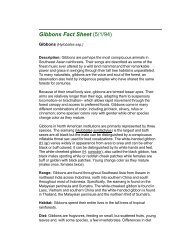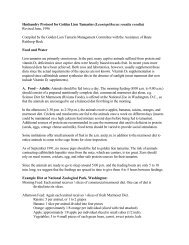Red Panda Nutrition Guideline.pdf - Nutrition Advisory Group
Red Panda Nutrition Guideline.pdf - Nutrition Advisory Group
Red Panda Nutrition Guideline.pdf - Nutrition Advisory Group
Create successful ePaper yourself
Turn your PDF publications into a flip-book with our unique Google optimized e-Paper software.
<strong>Red</strong> <strong>Panda</strong> <strong>Guideline</strong>s... for management and husbandry.<br />
Miles Roberts and Angela Glatston developed the management and husbandry guidelines<br />
listed below. They are the guidelines currently recommended by the <strong>Red</strong> <strong>Panda</strong> SSP, the<br />
Studbook and the International <strong>Red</strong> <strong>Panda</strong> Management <strong>Group</strong>.<br />
Diet<br />
1. General nutrition: <strong>Red</strong> pandas should be provided with a nutritionally balanced diet<br />
of a composition such as that shown in table 1.<br />
Dietary ingredients should be as fresh and of good quality - Every effort should be taken<br />
to avoid spoilage of the food during warm weather and freezing during cold. The use of a<br />
dry biscuit should help eliminate these kinds of problems. To further reduce this problem<br />
it is suggested that the animals are fed at least twice per day; at these times fresh food<br />
should be provided and the old food removed.<br />
In order to monitor food uptake and prevent disease it is recommended that food be<br />
presented in such a way that it is inaccessible to vermin. One solution to this problem is<br />
the feeding hut described in Studbook.<br />
2 Gruel/Biscuit<br />
Under normal circumstances red pandas should not be provided with gruel. The<br />
exceptions to this are discussed below<br />
Every effort should be made to convert red pandas to a nutritionally complete biscuit<br />
(pellet/cake is included in this term) diet. This biscuit should be very similar in nutrient<br />
composition to the one listed in table 2. Marion Zoological (Marion, Kansas) and Mazuri<br />
Feeds (Purina Mills, Richmond, IN) both make biscuits which have been used with<br />
success in North American Zoos. it is important to note that if one biscuit does not prove<br />
palatable, others may be used as long as they fall within the nutrient guidelines. Adult<br />
animals with a body weight of between five and six kilos, have been found to consume<br />
between 145-200 g. of biscuits (as fed) each day. This was measured in a maintenance<br />
situation i.e. when the animals were under little stress from the weather, not pregnant or<br />
lactating and in the absence of any other food item.<br />
Food consumption should be monitored closely and adjustments made in accordance with<br />
the number, size, weight and nutritional condition of the animals. <strong>Red</strong> pandas have a<br />
higher energy requirement in the winter months and probably also in late gestation,<br />
during lactation and especially during growth. During these times the animals should<br />
always be fed enough so as to have at least 3 % of the total food offered is left uneaten.<br />
When animals are housed together it may be important to offer food in more than one<br />
bowl and in several locations. This will ensure that all animals will have access to the<br />
same food items and will help prevent one animal from potentially dominating the food<br />
situation and excluding others from the more nutritious components of the diet.<br />
1
<strong>Red</strong> pandas which are off their food (this can occur in varying circumstances) can be<br />
tempted to eat by a sweetened gruel or by smearing their biscuits with a sweet product.<br />
(Slightly soaking the biscuits in orange juice has worked in some zoos). It is important<br />
that the sweetener/ gruel is withdrawn from the diet as soon as possible to avoid dental<br />
problems.<br />
Young pandas around the time of weaning are susceptible to death through starvation.<br />
Such deaths have been reported m young pandas ranging between 5-7 months. It is<br />
important to check young pandas regularly at this time. Young animals which are not<br />
accepting the normal diet adequately should be provided with a sweetened gruel and<br />
extra bamboo at this time. They can then be weaned onto the normal diet gradually.<br />
2. Bamboo<br />
If possible 200 g. of fresh bamboo leaves should be offered daily to each animal. The<br />
preferred sorts are Pseudosomas spp.<br />
It is desirable to obtain representative samples of the bamboo offered throughout the year<br />
and to have them chemically analyzed. Such an analysis is best conducted in a forage<br />
laboratory such as those of the local university or agricultural agencies. Protein (CP), fat<br />
(EE), acid detergent fiber (ADF), calcium (Ca) and phosphorous (P) are the main<br />
nutrients needed. If bamboo samples are similar in composition to the biscuit portion of<br />
the diet (no less than 18% protein, 0.5% CA and 0.4% P in a 1:1 to 2:1 Ca:P ratio) then<br />
more bamboo may be offered than the recommended 400 g of bamboo leaves, up to a<br />
maximum of 400g.<br />
If bamboo is unavailable or seasonally available then fiber must be incorporated into the<br />
concentrate portion of the diet (the biscuit). If an appropriate biscuit is not provided than<br />
an additional fiber source such as ground beet pulp must be provided in some acceptable<br />
form (possibly unsweetened gruel) or through and adequate source of grass and plants in<br />
the enclosure.<br />
3. Fruit and vegetables These are not important nutritionally to the diet of the red panda,<br />
in fact they can be harmful especially if offered in large quantities as they will dilute the<br />
nutrients in the biscuit thus lowering the nutrient content of the diet.<br />
Fruit and vegetables can be useful when providing medications to the animals as<br />
undesirablen substances can be presented in a palatable form.<br />
4. Water Fresh water must be available to all animals at all times of day. Care must be<br />
taken so that sufficient water is available and freezing is avoided. Sturdy ceramic bowls<br />
are usually suitable for providing water, where there is no fresh water available in the<br />
exhibit, as they are noteasily inverted. Animals with restricted water intake will also<br />
decrease food intake.<br />
Hand-Rearing<br />
1. Due to a powerful sucking response that could result in aspiration of liquid, animals<br />
2
should be fed initially by stomach tube (size 5-10 French, depending on animal size). A<br />
measured volume is delivered by syringe. The procedure is simple and easily taught to<br />
handlers by veterinary staff. Attempts at bottle feeding should be delayed until animals<br />
are well stabilized to milk formula (one week longer, depending on animal age and<br />
condition). Initial bottle feeding attempts should utilize a sterile solution of 5 % dextrose<br />
and 0.9% NaCl in case of aspiration. For young pandas the small teats designed for<br />
premature human infants may be appropriate. Bottle feeding can be adopted when<br />
controlled sucking is obtained. The size of the hole in the teat is important for regulation<br />
of milk flow rate and should be monitored periodically to avoid excessive milk flow.<br />
2. The milk formula used is a solution of powdered Esbilac (Borden, Inc.) in boiled water<br />
to which a lactase enzyme preparation (Lactald; Lactaid., 600 Fire Rd, P.O. Box 11l,<br />
Pleasantville, N.J. 08232) is added at rate of 1 drop per 100g formula.(Lactaid is<br />
available is a product used by persons with lactose intolerance). The formula should be<br />
predigested with the enzyme for 24 hours in a refrigerator or for 90 minutes at 90-95F<br />
(e.g. in a water bath). Due to possible bacterial contamination we use the 24 hour formula<br />
for one day only (discard at 48 hours after initial preparation). 90 minute formula is kept<br />
for only 12 hours prior to being discarded. Formula is kept refrigerated after the<br />
predigestion period and only the amount required for each feed is warmed prior to<br />
feeding.<br />
3. For the first few feeds the formula should be very dilute (7 % Esbilac by weight, i.e. 7g<br />
Esbilac, 93g boiled water, I drop Lactaid) to allow acclimation to formula constituents.<br />
Formula concentration is gradually increased in stepwise fashion (10%, 12%, 15%, 18%,<br />
20% Esbilac) according to animal performance and age. Thus the formula concentration<br />
might reach 15% strength in one week and 20% in three weeks. Formula is kept at this<br />
strength until weaning. In some instances pediatric vitamins (ABDEC, Parke-Davis,<br />
Morris Flains, N.J. 07950) or iron supplements have been given to hand reared red<br />
pandas but these not be necessary in most cases as Esbilac contains generous levels of<br />
these nutrients.<br />
4. Animals are initially fed at 3 hour intervals (8x per day). As the animals stabilize and<br />
get stronger the interval can be increased to 4 hours (6x per day). The amount fed per day<br />
is based on body weight; therefore it is essential to weigh the animals each day. A typical<br />
regimen for the first week would be 25-30% of body weight distributed over 8 feeds (3.1-<br />
3.8 % of body weight per feed). The amount to feed is recalculated at 3-4 days intervals<br />
based on body weight changes. As the animal ages the percentage of body weight fed per<br />
day is gradually reduced, e.g. at about one month old the panda is fed 20-25 % of its body<br />
weight per day, at 2 months old 16-18% per day and at 3 months old about 15% per day.<br />
These amounts are modeled after milk intakes of mother-reared carnivores; small<br />
(undersized) animals should be fed at the upper end of these percentage ranges.<br />
5. Weaning is commenced at approximately 3 months by addition of panda gruel (see<br />
below) to formula (e.g. I tsp. per bottle). Then animals must be taught to feed from a<br />
bowl, which can prove difficult. In one case the teat had to be placed in the bowl of<br />
formula to initiate feeding. The amount of gruel added is gradually increased such that<br />
3
animals are fully weaned by 5 to 6 months. <strong>Red</strong> pandas resist rapid dietary change.<br />
Bamboo and salad (apple carrot, green bean) are offered separately from about 70-90<br />
days to allow manipulation and nvestigation, they may not be eaten at first. Water should<br />
be made available as solids are introduced.<br />
6. The gruel to which animals are weaned is prepared daily, kept refrigerated and the<br />
excess discarded after 24 hours. A batch of about 760g is composed of the following:<br />
114g Gerber's mixed cereal, 276g evaporated milk, 57g applesauce, 1 tablespoon<br />
vitamin-mineral supplement (Pervinal, Pet Products & Co., Brentwood, N.Y. 11717), 1/2<br />
tablespoon honey, 2 egg yolks and 284 g boiled water.<br />
7. Hand reared red pandas gain weight at a rate equal to or above that of motherrearedyoung.<br />
Weights of hand reared animals are provided below . Early weights of<br />
animals pulled due to small size are excluded (i.e. animals much smaller than those below<br />
are underweight) -<br />
birth ca. 100 g 10 weeks 0.9 - 1.4 kg<br />
2 weeks 160 - 210 g 3 months 1.3 - 1.9 kg<br />
4 weeks 260 - 360 g 4 months 1.8 - 2.6 kg<br />
6 weeks 460 - 650 9 5 months 2.4 - 3.7 kg<br />
8 weeks 650 - 960 g 6 months 3.2 - 4.8 kg<br />
8. Additional considerations: Animals should be reared as a group to prevent abnormal<br />
socialization as they mature. Since young animals tend to suck on each other, they may<br />
need to be housed separately for an initial period.<br />
Stimulate young animals to induce elimination. Older animals may develop soreness in<br />
the anal region from frequent scent marking (anal rubbing) of objects in the enclosure.<br />
The normal range for rectal temperature appears to be 95.4- 98F. Rectal temperatures<br />
above 99-100F may indicate a medical problem. Rectal temperature should be monitored<br />
once or twice a day in young animals.<br />
Young pandas are initially kept in an incubator or warm box at 85-90 F. As they mature,<br />
they are prone to heat the stress. Fans can help in hot weather.<br />
Provide climbing apparatus for older animals but beware: red pandas are escape artists.<br />
Nails will require periodic trimming, even so it may be necessary to wrap older animals<br />
in a towel for feeding to avoid scratches. Handlers, will need heavy trousers when<br />
animals start to climb on them.<br />
9. In order to aid the development of a new milk substitute any zoo which has to sedate a<br />
lactating panda is asked to obtain a milk sample for analysis.<br />
4



